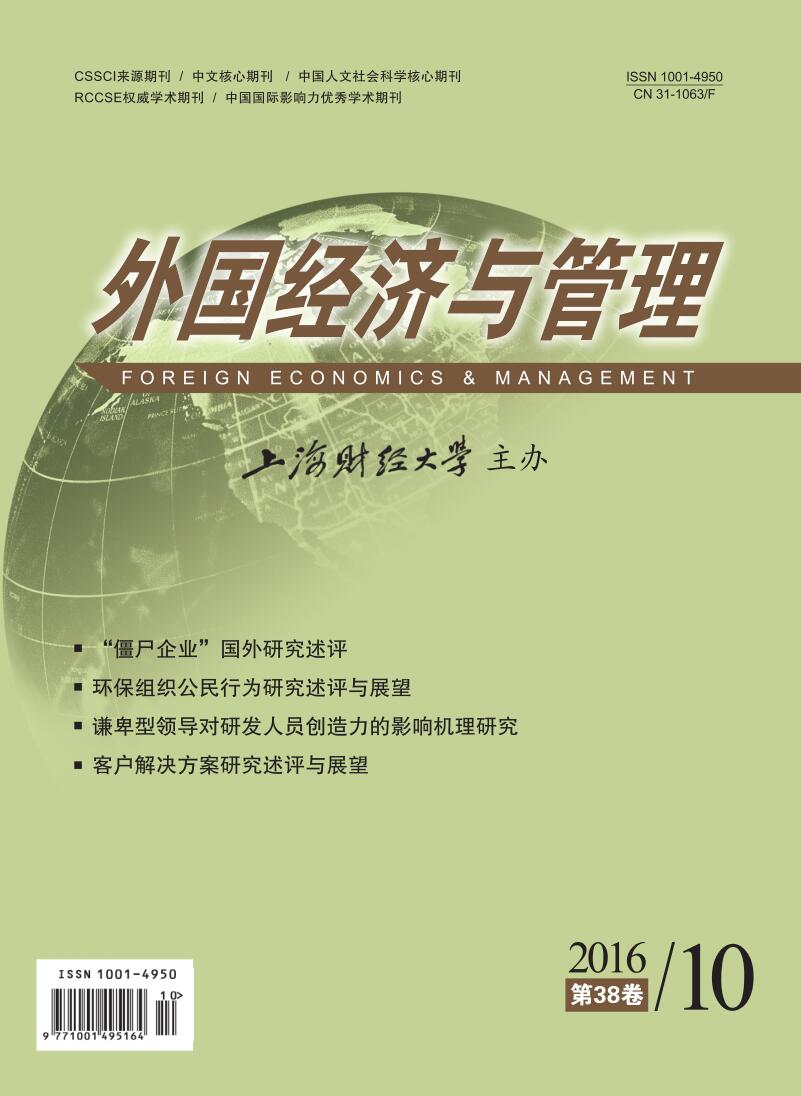“僵尸企业”通常是指那些陷入财务危机但依靠债权人的帮助依然维持生存的企业。当前,我国“僵尸企业”问题日益突出并产生严重后果。2000年之后,国际学术界关于“僵尸企业”的研究开始涌现,而国内关于“僵尸企业”的学术研究则非常稀缺。因此,本文全面回顾了国外有关“僵尸企业”研究的进展,对“僵尸企业”的内涵界定、识别方法、形成原因、影响效应等相关问题进行了梳理。综述发现:对“僵尸企业”的界定需要满足“陷入财务危机”和“债权人继续提供借贷”两个标准;银行掩盖不良贷款问题的动机是“僵尸企业”形成的重要原因;“僵尸企业”会阻碍行业生产率的提高和经济增长。本文对于国内学者把握“僵尸企业”研究的脉络和未来的研究方向、增进对“僵尸企业”的认识和寻找相应的解决方案具有一定的借鉴意义。
“僵尸企业”国外研究述评
摘要
参考文献
1 (日)青木昌彦, 周黎安译.比较制度分析[M].上海:上海远东出版社, 2001.
4 Ahearne A G, Shinada N. Zombie firms and economic stagnation in Japan[J]. International Economics and Economic Policy, 2005, 2(4):363-381. DOI:10.1007/s10368-005-0041-1
5 Albertazzi U, Marchetti D J. Credit supply, flight to quality and evergreening:An analysis of bank-firm relationships after Lehman[R]. Working Paper, 2010.
6 Aoki M, Dinc S. Relational financing as an institution and its viability under competition[R]. Working Paper, 1997.
7 Arrowsmith M, Griffiths M, Franklin J, et al. SME forbearance and its implications for monetary and financial stability[J]. Bank of England Quarterly Bulletin, 2013, 53(4):296-303.
8 Berglöf E, Perotti E. The governance structure of the Japanese financial keiretsu[J]. Journal of Financial Economics, 1994, 36(2):259-284. DOI:10.1016/0304-405X(94)90026-4
10 Brown C O, Dinç I S. Too many to fail? Evidence of regulatory forbearance when the banking sector is weak[J]. Review of Financial Studies, 2011, 24(4):1378-1405. DOI:10.1093/rfs/hhp039
11 Bruche M, Llobet G. Preventing zombie lending[J]. Review of Financial Studies, 2014, 27(3):923-956. DOI:10.1093/rfs/hht064
12 Caballero R J, Hoshi T, Kashyap A K. Zombie lending and depressed restructuring in Japan[J]. American Economic Review, 2008, 98(5):1943-1977. DOI:10.1257/aer.98.5.1943
13 Chakraborty S, Peek J. Cherry-picking winners or aiding the distressed? Anatomy of a financial crisis intervention[R]. Working Paper, 2012.
15 Fukao K. Explaining Japan's unproductive two decades[J]. Asian Economic Policy Review, 2013, 8(2):193-213. DOI:10.1111/aepr.12020
16 Fukuda S I, Kasuya M, Akashi K. The role of trade credit for small firms:An implication from Japan's banking crisis[R]. Working Paper No. CARF-F-078, 2006.
17 Fukuda S I, Nakamura J I. Why did "zombie" firms recover in Japan?[J]. The World Economy, 2011, 34(7):1124-1137. DOI:10.1111/twec.2011.34.issue-7
19 Giannetti M, Simonov A. On the real effects of bank bailouts:Micro evidence from Japan[J]. American Economic Journal:Macroeconomics, 2013, 5(1):135-167. DOI:10.1257/mac.5.1.135
20 Hoshi T, Kashyap A K. Will the TARP Succeed?Lessons from Japan[R]. Working Paper No. 14401, 2008.
21 Hoshi T, Kashyap A K. Will the U.S. bank recapitalization succeed? Eight lessons from Japan[J]. Journal of Financial Economics, 2010, 97(3):398-417. DOI:10.1016/j.jfineco.2010.02.005
22 Hirata W. Financial market imperfections and aggregate fluctuations[D]. Boston:Boston College, 2010.
23 Hoshi T, Kashyap A. Why did Japan stop growing?[R]. Working Paper, 2011.
24 Hoshi T, Kim Y. Macroprudential policy and zombie lending in Korea[R]. Working Paper, 2012.
25 Imai M. Local economic effects of a government-owned depository institution:Evidence from a natural experiment in Japan[J]. Journal of Financial Intermediation, 2012, 21(1):1-22. DOI:10.1016/j.jfi.2011.06.001
26 Jaskowski M. Should zombie lending always be prevented?[J]. International Review of Economics & Finance, 2015, 40:191-203.
27 Kane E J. Dangers of capital forbearance:The case of the FSLIC and "zombie" S & Ls[J]. Contemporary Economic Policy, 1987, 5(1):77-83. DOI:10.1111/coep.1987.5.issue-1
28 Kane E J. What lessons should Japan learn from the U.S. deposit-insurance mess?[J]. Journal of the Japanese and International Economies, 1993, 7(4):329-355. DOI:10.1006/jjie.1993.1021
29 Kashyap A K. Sorting out Japan's financial crisis[R]. Working Paper No. 9384, 2002.
30 Kato K, Skinner D J, Kunimura M. When voluntary disclosure isn't voluntary:Management forecasts in Japan[R]. Working Paper No. 2005-09, 2006.
31 Kawai M, Morgan P. Banking crises and "Japanization":Origins and implications[R]. Working Paper No. 430, 2013.
32 Kwon H U, Narita F, Narita M. Resource reallocation and zombie lending in Japan in the 1990s[J]. Review of Economic Dynamics, 2015, 18(4):709-732. DOI:10.1016/j.red.2015.07.001
33 Lin Y P. Zombie lending, financial reporting opacity and contagion[D]. Singapore:National University of Singapore, 2011.
34 Lin Y P, Srinivasan A, Yamada T. The effect of government bank lending:Evidence from the financial crisis in Japan[R]. Working Paper, 2015.
35 Morrison A D, White L. Reputational contagion and optimal regulatory forbearance[J]. Journal of Financial Economics, 2013, 110(3):642-658. DOI:10.1016/j.jfineco.2013.08.011
36 Nakamura J I, Fukuda S I. What happened to "zombie" firms in Japan? Reexamination for the lost two decades[J]. Global Journal of Economics, 2013, 2(2):1-18.
37 Okada Y. Competition and productivity in Japanese manufacturing industries[J]. Journal of the Japanese and International Economies, 2005, 19(4):586-616. DOI:10.1016/j.jjie.2005.10.003
38 Okamura K. "Zombie" banks make "zombie" firms[J]. Working Paper, 2011.
39 Ota T. Forbearance and broken credit cycles[R]. Working Paper, 2013.
40 Papava V G. The problem of zombification of the postcommunist necroeconomy[J]. Problems of Economic Transition, 2010, 53(4):35-51. DOI:10.2753/PET1061-1991530403
41 Peek J. The contribution of bank lending to the long-term stagnation in Japan[R]. Working Paper, 2008.
42 Pessoa J P, Van Reenen J. The UK productivity and jobs puzzle:Does the answer lie in wage flexibility?[J]. The Economic Journal, 2014, 124(576):433-452. DOI:10.1111/ecoj.12146
43 Rawdanowicz Ł, Bouis R, Watanabe S. The benefits and costs of highly expansionary monetary policy[R]. Working Paper No. 1082, 2013.
44 Ridzak T. Lending activity and credit supply to firms during the crisis-evidence from the Croatian micro level data[A]. The Seventeenth Dubrovnik Economic Conference[C]. Croatian:Croatian National Bank, 2011.
45 Senbet L W, Wang T Y. Corporate financial distress and bankruptcy:A survey[J]. Foundations and Trends in Finance, 2012, 5(4):243-335.
46 Tanaka T. Banks, unhealthy firms, and product market competition:Evidence from Japan[R]. Discussion Paper No. 247, 2008.
47 Uchida H, Miyakawa D, Hosono K, et al. Financial shocks, bankruptcy, and natural selection[J]. Japan and the World Economy, 2015, 36:123-135. DOI:10.1016/j.japwor.2015.11.002
48 Ueda K. Deleveraging and monetary policy:Japan since the 1990s and the United States since 2007[J]. Journal of Economic Perspectives, 2012, 26(3):177-202. DOI:10.1257/jep.26.3.177
49 Watanabe W. Does a large loss of bank capital cause Evergreening? Evidence from Japan[J]. Journal of the Japanese and International Economies, 2010, 24(1):116-136. DOI:10.1016/j.jjie.2010.01.001
50 Watanabe W. Prudential regulations and banking behavior in Japan[J]. Japanese Economy, 2011, 38(3):30-70. DOI:10.2753/JES1097-203X380302
51 Wilcox J A. Why the U.S. won't have a "lost decade"[R]. Working Paper, 2008.
52 Willam D. Zombie banks and forbearance lending:Causes, effects, and policy measures[D]. Leipzig:Universität Leipzig, 2014.
引用本文
刘奎甫, 茅宁. “僵尸企业”国外研究述评[J]. 外国经济与管理, 2016, 38(10): 3–19.
导出参考文献,格式为:





 11210
11210  13072
13072

